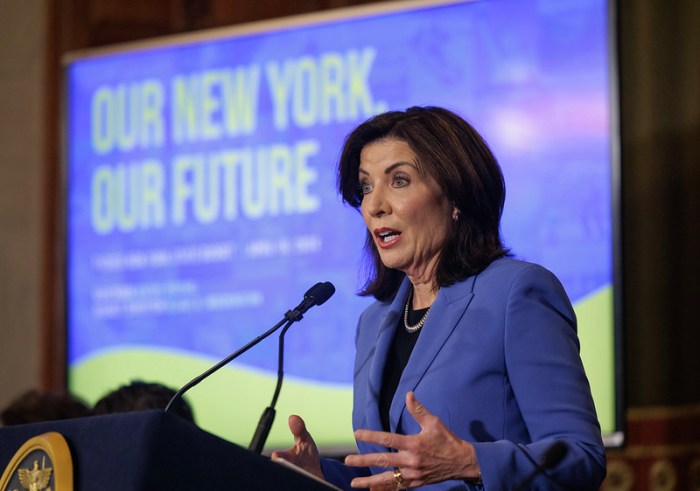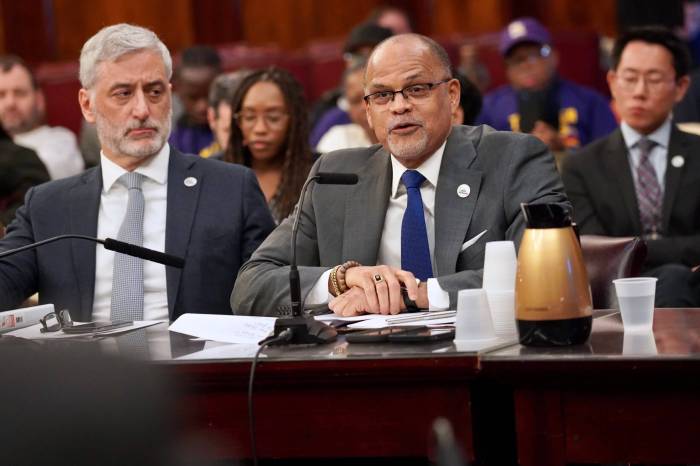
BY DENNIS LYNCH | Rumors flying that President Donald Trump plans to completely eliminate the National Endowment for the Arts and the National Endowment for the Humanities have local arts organizations and politicians up in arms over what would be a devastating blow to cultural programs in the city.
The two national endowments write hundreds of thousands of dollars worth of checks to dozens of dance companies, foundations, galleries and individual artists in Downtown and Lower Manhattan, mostly for works on specific projects. The impact of a loss in N.E.A. and N.E.H. funding for Downtown arts would be much more than cultural, according to Bruce Allardice, the executive director of Ping Chong + Company. The theater company, based at 47 Great Jones St. in Noho, has received dozens of grants over the last quarter century.
“What is the biggest impact the arts has in Downtown? The arts brings people to the Village — to restaurants and bars,” Allardice said. “It helps our urban culture be vibrant, that’s why so much of the N.E.A.’s work has a community-development aspect. The economic impact if that were to end is quantifiable.”
Ping Chong + Company received $25,000 this year to fund its production “Where the Sea Breaks Its Back,” a multidiscipline show about Alaskan culture and history. The show will premiere and tour in Alaska before coming to New York. More rural parts of the country, including Alaska, where art — and funding for it — is far more scarce than in the Village stand to lose far more if programs such as the national endowments were abolished, Allardice said.
“In the end, the arts are an ecology,” he said. “So the loss of N.E.A. support, if that were to happen, will be devastating, particularly to smaller communities and arts organizations across the country.”
The N.E.A. grant makes up only about 10 percent of the funding for “Where the Sea Breaks Its Back,” but is used as leverage for raising funds from other sources. Each N.E.A. grant comes with an obligation to raise three times that amount from other sources. Ping Chong won’t have to shut its doors, Allardice said, but the arts community — and the community as a whole — will suffer.
The relatively small grants can mean a lot, especially to small arts organizations. But it’s a drop in the bucket in terms of the national budget: The combined $298 million cost of the N.E.A. and N.E.H. is roughly 0.006 percent of the $3 trillion federal budget. That’s less than 94 cents per capita per year to fund.
However small a slice it is, though, the federal government currently is running a $441 billion deficit for fiscal year 2017, and Republicans are looking at a myriad of cuts to slash federal spending by $10.5 billion over the next decade. Congress will have to sign off on the cuts and Republicans have control of both the Senate and House of Representatives.

Over the years, Republicans criticized the N.E.A. in particular for partially funding what some call inappropriate art. Debate was the most fervent in 1987, a year after the N.E.A. provided $5,000 to photographer Andres Serrano, who then created the controversial “Piss Christ” photograph of a plastic crucifix submerged in his own urine.
In 1990, East Village performance artist Karen Finley and three other artists sued the N.E.A. after its chairperson vetoed their grants based on subject matter. They won their case in ’93, but the N.E.A., pressured by Congress, promptly ceased funding individual artists.
Risa Shoup is the executive director of the Fourth Arts Block, a.k.a. FAB, which advocates for local cultural and arts groups, plus helps maintain affordable rehearsal spaces for rent on E. Fourth St. and at other East Village and Lower East Side locations. She said defunding the national endowments would be an “egregious thing to do,” and called it indicative of a wider effort to combat dissent.
“This is not a cost-cutting decision,” she said. “This is some kind of symbolic decision meant to assert dominance over those of us on the left — and I would go so far as to say over those of us in the arts who are making space for creative expression, which naturally creates a platform for dissent and disagreement with this administration.
“We must align with our friends and partners who advocate for affordable housing, civil liberties, immigrant rights, public education and other sectors to continue to co-create spaces to share, gather and support,” Shoup said. “We are in this for the long haul.”
Congressmember Carolyn Maloney, whose district covers most of Manhattan’s East Side, including the East Village and part of the Lower East Side, plus parts of Brooklyn and Queens, sharply criticized the administration’s plan. The Manhattan portion of her 12th District is home to hundreds of individuals and organizations that receive funds through the endowments.
“The arts and humanities represent who we are as a society,” Maloney said. “They open minds, expand people’s imaginations and their knowledge, empower creativity, bridge cultural gaps and so much more. Our nation needs more access to the arts and humanities, not less.”
The rumors spread after a pre-inauguration report in The Hill citing anonymous sources with the Trump transition team. The plan would also privatize the Corporation for Public Broadcasting, which runs National Public Radio (NPR) and the Public Broadcasting Service (PBS), and reduce funding for many federal agencies, including the Department of Commerce and Department of Energy, according to The Hill.
“Piss Christ” was only one battle in the war over the endowments, though. In 1981, then-President Ronald Reagan wanted to do away with the two agencies when he took office, although he ended up cutting only 10 percent of their budget. Congressmember Newt Gingrich went after the N.E.A. in the following decade, and in 1997 its budget was cut by 40 percent. A group of 165 House Republicans wanted to cut it again in 2011 and an agreement was reached to cut it by 6 percent.
















